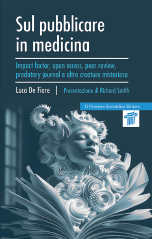BOOK REVIEWS, NOTES AND COMMENTS

SUL PUBBLICARE IN MEDICINA
Impact factor, open access, peer review, predatory journal e altre creature misteriose
Luca De Fiore
Roma: Il Pensiero Scientifico Editore; 2024
182 p
18,00 €
ISBN: 9788849007756
[On medical publishing. Impact factor, open access, peer review, predatory journal, and other mysterious creatures]
Nowadays, the STM (Science, Technology, Medicine) publishing market represents 5% of all the editorial market with 36,000 journals and 5 million articles published each year (2023 data). These numbers, among other factors, are the result of the famous “publish or perish” principle, that pushes researchers in the world to publish continuously in order to have a career, and the advent of internet which has made possible the digitalization of a big segment of the editorial process and, consequently, the publication of a vast number of articles. Not to mention the fact that these huge profits are mostly obtained thanks to the unpaid work of editors, peer reviewers and authors.
Although the numbers that characterize it are overwhelming, scientific publishing is going through a period of great precarity. In his book Sul pubblicare in medicina. Impact factor, open access, peer review, predatory journal e altre creature misteriose, Luca De Fiore (the CEO of Il Pensiero Scientifico Editore, a STM Publishing Company, with an experience of over 40 years in the field of publishing) starts with a reflection on a Richard Horton (Editor-in-Chief of The Lancet) phrase of the 2016 “the state of scientific publishing today has never been more precarious” to address very critically the current state of the art of STM publishing.
The book is introduced by a text written by Richard Smith (former Editor-in-Chief of The BMJ), giving interesting insights on the birth of the modern scientific publishing. After a first chapter devoted to illustrating the (huge!) numbers of the scientific publishing industry, the subsequent chapters analyze, in an fluent but detailed style, the peculiar critical issues of today’s scientific publishing: from the lights and shadows of Open Access to the peer review’s difficulty of acting as a quality filter, from predatory journals to paper mills, review mills and retractions, from the recent impact of the artificial intelligence to the integrity of the scientific communication, from bibliometric narcissism to the impossibility of citation indexes to define the real value of contents.
In the last chapter, titled “Rethinking the scientific information system”, Luca De Fiore affirms that “the system should be rethought from its foundations” asking for a major cultural shift, internationally and at local level, with some helpful concrete suggestions for a real cultural change, or a “possible revolution”, that could significantly improve the scientific communication system: publish less (but more in-depth) research, increase the transparency of research outputs, involve doctors and patients in research planning, publish original research on public platforms and transform journals into a space for discussion with perspectives and comments, and, last but not least, teach the principles of science ethics along with more conventional material at school.
The book is an easy, well documented, and informative read giving food for thought, and bibliographic references to delve deeper into the topic. A well thought out “Index of questions” adds further value.
The interesting topic and the clear and accessible style should make it of great interest to readers from the academic/research world and to citizens interested in this crucial theme.
Annarita Barbaro
Scientific Communication Unit
Istituto Superiore di Sanità, Rome, Italy
